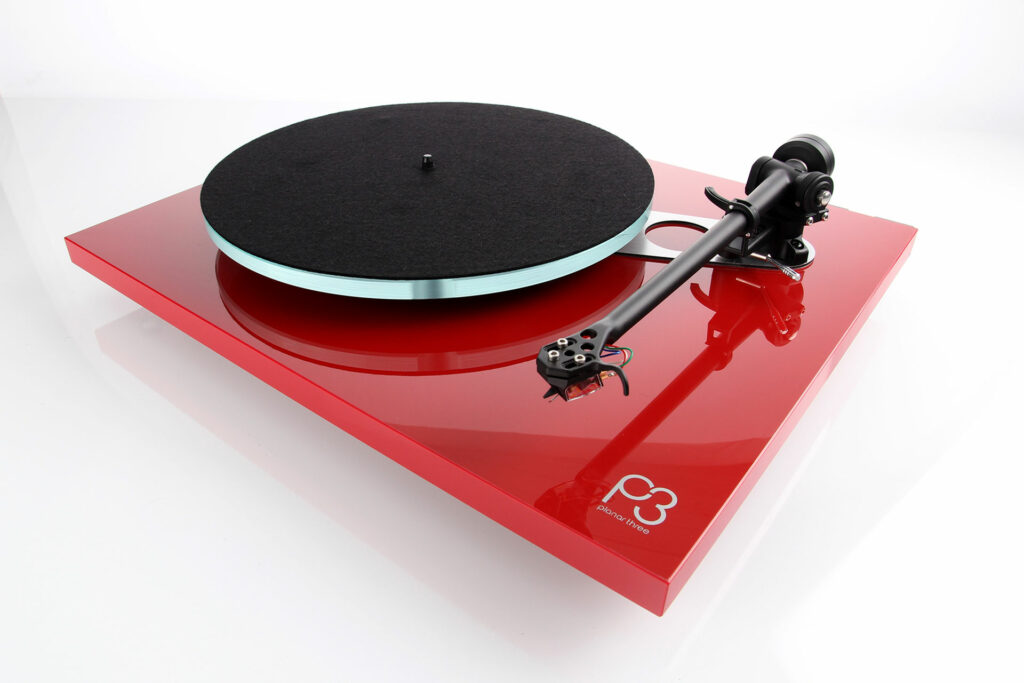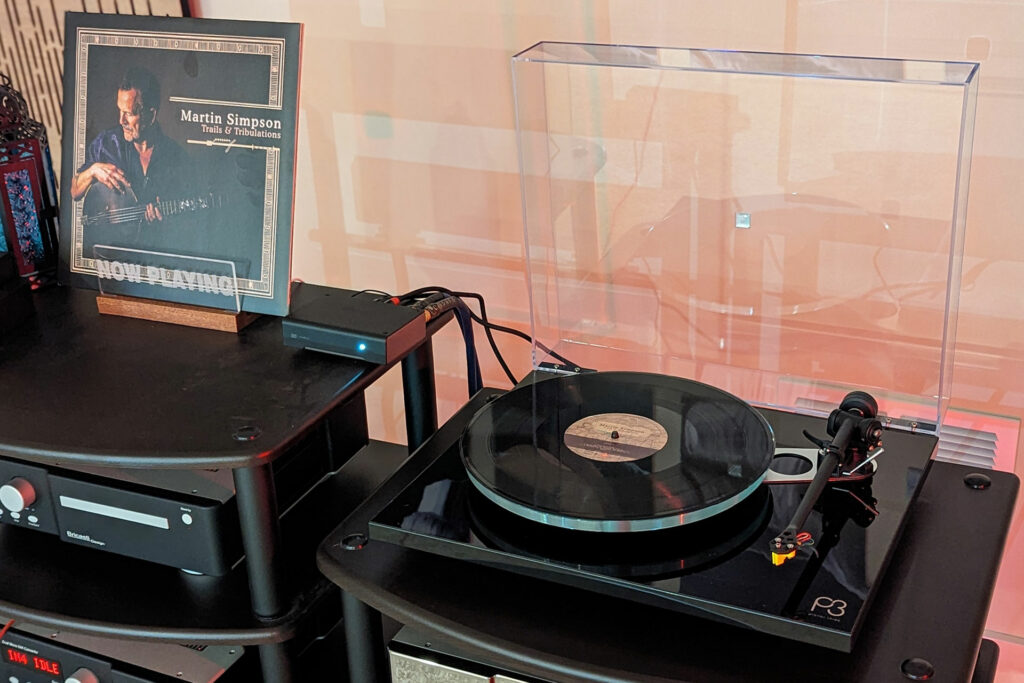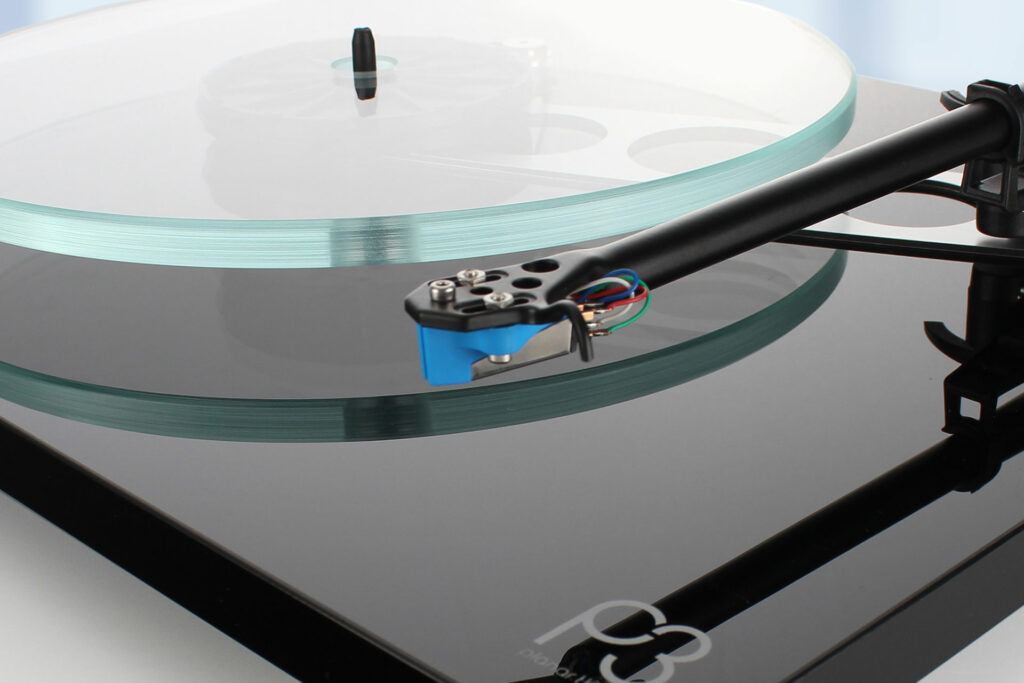Rega is a blue-chip brand in the audiophile community, and there are many good reasons why. For starters, every product has been painstakingly built by hand in England since 1973. Engineering is one of Rega’s founding pillars. Rega has built a reputation for delivering stellar performance at value-minded prices, which is always popular with audiophiles. I can go on and on, however, the bottom line is: In my experiences with Rega, which now date back to the 1990s (holy crap, I’m getting old…), I have always been impressed. My primary listening is either through my networked Bricasti M1 Series II DAC (read the review), or through Qobuz, but I do spin my Rega Planar 1 turntable (read the review) quite often with the modest vinyl collection that I currently own. Bolstering my analog acuity is next on my audiophile “to do” list, so one can imagine the excitement I had when I found the Rega Planar 3 (P3), which by many is considered one of their best high-end turntable values was on its way for evaluation.
The Rega P3 sits two significantly higher levels above my P1. The P3 is a completely different turntable in terms of materials, motor, bearings, tonearm and build quality. It should be, for double the price of the Rega P1. All too many companies these days are slapping accessories on their entry-level products and selling them for big dollars. Hell, I see it in one half of the pictures coming out of the AXPONA show as I am writing this. Not Rega, though. Each of their turntables is carefully engineered and curated, as their own unique products are built to deliver unparalleled value and deeply engaging sound. All of the hype considered, as I head into the evaluation of the P3, the high-performance expectations that Rega has sowed in my mind had better bear some fruit.

What Makes the Rega Planar 3 So Special?
- The Rega P3 has a legacy of performance. The P3 has been around in one form or another for years. It is constantly revisited and improved upon, and over generations, it has gotten perfected and honed in using modern engineering’s best practices. Rega never rests on their laurels, and puts action forward to show their culture of continuous improvement in the P3.
- One area Rega in which demonstrates their dedication to continuous improvement in the P3 is in its extremely advanced plinth. The plinth, or the base, of the turntable is one of the most important contributors to a turntable’s sound. While many companies think they will just power their way to good sound through heavy-mass plinths, Rega finds the opposite is true. A low-mass rigid core with a skeleton of bracing to support the table motor, and tonearm wrapped firmly in a phenolic resin result in minimized vibration transfer that can negatively affect the sound.
- The Rega P3 includes the RB330 tonearm, which represents their 35-plus years of tonearm design experience. From the tonearm tube to the precision bearings and fine adjustments, the RB300 is its own engineering marvel. For Rega to include it on the P3 shows their dedication to value.
- A 24-volt, low-torque, asynchronous motor drives the thick glass platter of the P3. There are two things to address here. First, speed stability and the elimination of noise are two extremely important must-haves of motors in turntables. Since we are not pulling a hay baler across a farm with a Kubota tractor (high-torque), the low-torque motor is ideal for precise speed stability and low noise. Second, the asynchronous motor allows for the use of Rega’s separate NEO PSU MKII speed controller to provide further speed stability. The better the stability, the better the measurable wow and flutter. The lower the noise, the better the measurable dynamic range.
- For this year (2024), the Rega P3 is now available in a handsome light oak finish. My sample came in traditional gloss black. Modern white and red are also still available to insure the P3 remains a proud display piece when not in use.
- I love-love-love that the P3 still comes with a high-quality dust cover. My listening room is dedicated and closed-off from the remainder of my home, yet it still gets dusty. The dust cover is truly a simple must-have to avoid dust from getting into a turntable’s precision parts.
- The main hub central bearing has been redesigned on the P3. Precision improvements have been made to the already quiet and smooth bearing system on the P3, improving the table’s longevity and performance.
- The Rega P3 comes without a cartridge, with the Elys 2 moving magnet (MM) cartridge, or the Exact MM cartridge. With no cartridge, the P3 is $1,125. The most common set-up is with the Elys 2 cartridge for $1,395. The Exact cartridge affixed by the factory to the P3 weighs in at $1,595. The unit I received came fitted with the Exact.
- The Rega P3 is very user-friendly to set up for a rather advanced turntable. Rega thinks of every detail, right down to how their customers will interact with and set up their product. If you are new to vinyl, and intimidated by a table with many fine adjustments, the P3 is a great place to start, since set-up is a breeze. I had a turntable pro to help me out with the precision set-up tools, and would certainly recommend it, but it is not necessary for great sound from the P3.

Why Should You Care About the Rega Planar 3 Turntable?
Vinyl is here to stay, even if physical media sales are at an all-time low in the current music industry boom. Here is what I say: Eat your hat, Mr. Reporter, I am still buying new vinyl on the regular and hunting at yard sales and music stores … And I am not the only one. In fact, there are many of us. When advanced engineering and technology becomes affordable at reasonable levels, as the P3 demonstrates, all the audiophile fun we so desperately seek becomes far more accessible since the music pulled off those 12-inch plastic discs is higher fidelity and more understandable. The Rega P3 is birthed from generations of continuous improvement and study, to bring what I consider to be true high-end turntable performance to a level everyone can afford. This is important for us as music lovers, but also for the hobby at large, to keep the market competitive and honest.

Some Things You Might Not Like About the Rega Planar 3 Turntable
- The Anti-Skate is very touchy on the RB300 tonearm. Even using the Cardas “Frequency Sweep and Burn-In” record during the precision set-up to hone in the anti-skate, it took a little further adjustment by ear to get the soundstage where it should be.
- The cue level is a little slow to drop. No one is into slamming an expensive cartridge into their vinyl. However, when dropping the tonearm via the cue level, it was a little slow at times, which made for a rough start to a few tracks until I could get used to the timing.
- The RCA cables are not user-replaceable on the P3. Some people find their sonic religion in certain cables. These audiophiles will be upset that they cannot use the cable of their choice with the P3. However, from an engineering standpoint, keeping a continuous connection from the cartridge with as few breaks as possible is more important to the sound than a brand-name cable.
- The Rega P3 really benefits from a precision set-up. The set-up Rega provides with the P3 is adequate, but if you want the most from it, good protractors, scales and leveling tools are necessary. All of these things cost extra.

Listening to the Rega Planar 3 Turntable…
I am convinced the $149 Schiit Mani II is the best overall performing phono preamplifier under $1,000. Go ahead, find something that can beat it in every aspect of listenable performance, and I will stand on the corner of a busy intersection with a sign saying that I was wrong. The point is that the Schiit Mani II was the phono stage paired with the P3. I listened mainly through the Wharfedale Aura 1 (read the review) bookshelf loudspeakers, but used the P3 and some vinyl to do a musical shootout between my Sonus faber Lumina V and the PSB T65 loudspeakers (review pending). Once the P3 was properly set up, and the Exact cartridge smoothed out from 25 or so repetitions of playing the Cardas burn-in record, I was ready to rock.
What better to rock with than the album from Alice in Chains, Dirt. Colombia had recently released Dirt completely remastered from the original tapes. Dirt is one of my all-time favorite albums. From the first note of Alice in Chains’ famous song “Rooster,” the P3’s performance far exceeded the two levels higher in Rega’s product line than the P1 I own. The P3 was dead neutral in terms of tonality, but had a very smooth, almost silk-like sonic signature that made the hard-hitting chorus of “Rooster”speak straight to the heart. The high-frequency information was extended and smooth, the guitars were fat and textured, and the harmonies between Jerry Cantrell and Layne Staley were separated from each other, locked in the soundstage where they should be. The unmistakable bass line anchored the music with body and depth, and the drums did not lack any snap. I was a little taken aback as I began to form a realization, but we will get to that realization in the conclusion – so stay tuned. In the meantime, there is much more to be excited about in the P3’s sound, so let’s keep our focus there.
I have been a huge fan of American folk artist Martin Simpson for decades now, thanks to his absolute mastery of guitar without any excessive showmanship, always getting to the heart of the song he is playing. In 2017, Simpson released Trials and Tribulations. Third track in, you will hit the song “Thomas Drew,” which is written by the ghost of a gambler who was shot over a quarter, and upset no one will know his name, while everyone knows the name of his killer. The P3 brought “Thomas Drew” to life. It was with this track that I noticed just how stone-quiet the P3 is. The lack of noise helped flesh out the extreme subtleties of Simpson’s delicate and often quiet playing. The vocal harmonies were soulful and silky on the P3, and when added to Simpson’s thin but meaningful voice, none of the complexities in the midrange got muddled together. I also found the fretless bass guitar to be very true to the instrument. The sound of the bass was deep and full, but maybe had just a small hint of excess warmth in the upper bass frequencies. Despite the extra warmth, I deeply enjoyed “Thomas Drew” on the P3, even more so than the digital version of the song that I often stream.
I’ll close out the listening with a 2003 re-issue pressing of the Rolling Stones’ album Let It Bleed. There is one song that the Stones made famous in 1969, but it was originally recorded by blues legend Robert Johnson in 1937. That song is “Love in Vain.” This song has some great dynamic guitar that the Rega P3 resolved perfectly. Every pluck has a distinct beat to the string coming off the pick, and when the electric slide guitar came in, it was textured and full. The drums hit hard, and while the bit of excessive upper-bass warmth was there, the simple bass line held the piece together well. Mick Jagger’s voice was soulful on the P3, and its curt, direct nature never became offensive to listen to. Again, I found the cymbals and other high-frequency details to have plenty of air, while the soundstage was wide and three-dimensional. I can really understand why the Rega P3 is a legendary, high-value turntable.

Will the Rega Planar 3 Hold Its Value?
I mentioned that Rega is a blue-chip audio brand, and this always helps boost equipment’s value in the used market. Turntables in general can be tough in the resale market, because they are mechanical devices, and their used value is heavily reliant on wear, tear, maintenance and care. Packing and shipping can be no fun, too, and getting the P3 back into its original packaging is cumbersome. All that aside, I would expect the P3 to hold on to close to half of its retail value for a good number of years, as long as you take care of it well from original set-up to the day it ships.

What is the Competition for the Rega Planar 3 Turntable?
There are a lot of turnkey turntable options out there, and I have yet to hear them all. Turntables are hard to compare, too, because one never knows how well they are set up in a demo space. Was the set-up done by an overly enthusiastic newcomer to the audiophile world, or was the set-up painstakingly done in every measurable aspect by a veteran of vinyl? With that quasi-disclaimer out of the way, here are a few tables which, if set up properly, and all other system elements are equal, could give the P3 a run for its money.
Brian Khan reviewed the Marantz TT15S1 (read the review), which rings in at $1,799. Marantz has changed hands a couple of times, and looks like it will again soon, thanks to Masimo’s pending exit from the consumer electronics industry. Since Marantz partnered with Clearaudio on the TT15S1, it comes with some heavy-hitting engineering that, when set up properly, may just nip at the P3’s heels when the P3 is equipped with the Elys cartridge. The Marantz, however, lacks a dust cover, has the motor and belt exposed, and does not allow for an upgrade path, such as a speed controller.
Pro-ject is another long-time player in the field of high-end turntables and, for $2,499, you can find yourself with their X8 Evolution. The X8 Evolution has some serious features, like Pro-ject’s true balanced technology, a carbon fiber tonearm, and a mass loaded platter that is supported by a magnetically-assisted bearing. All of these technologies show a different engineering path than Rega took with the P3, yet are no less significant. The X8 Evolution does not come with a cartridge, and a good one will defiantly drive the price up. One of Rega’s magical powers is their ability to provide the $695 Exact cartridge packages with the P3 for $1,595, providing all-in value.
Another turntable model that, like the P3, has a long-standing heritage of excellence is the Music Hall MMF 7.3 ($1,999 – buy at Crutchfield). If you purchase the MMF 7.3 with the Ortofon 2M Bronze cartridge, it will set you back $1,995. A lot of continuous improvement and technology is packed into the MMF 7.3, including a carbon fiber tonearm, Teflon-infused main bearing, and a dual-layer plinth with enhanced vibration reduction to isolate any noise-generating components. The MMF 7.3 also has RCA connections for those who must use their cable of choice. However, the MMF 7.3 does cost more than the P3, the cartridge is not quite as nice as Rega’s Exact, and there are no upgrades available, such as a speed controller.

Final Thoughts on the Rega Planar 3 Turntable…
The Rega P3 is the turntable gateway to true high-end performance and provides an exceptional value that many audiophiles should consider. The P3 can be a little touchy to set up, and has a little extra warmth in the upper bass at times, but those are likely necessary evils at its quite modest selling price. Many audiophiles cannot shell out thousands of dollars all at once, and I really dig the fact the Rega P3 has an upgrade path with the NEO PSU MKII.
While writing about the music above, I mentioned a realization that I had, which the P3 brought to light. It goes a little something like this: All technobabble and measured specifications aside, when listening and enjoying music for the sake of getting as close to the artist’s message as possible, the Rega P3 provides no less of a musical experience than my very expensive digital set-up does. It’s a win for vinyl lovers everywhere. However, this joyful note comes with an extremely large asterisk: The P3 does not even scratch the surface of the capability in my digital set-up in every describable aspect of the sound. So where does this leave me?
I want both. The more ways we can experience the music, the better. If the Rega P3 can provide just as enjoyable an experience with a $149 phono stage as a higher-priced digital set-up, it is very understandable why so many audiophiles turn to excellent analog products like the P3 as their choice of primary source component. There is a lot more to this realization, and there is the outright schlep of turntable/vinyl maintenance and set-up to consider. However, I think it is better to leave it be for now. I am going to simply enjoy the music, and appreciate what a great value Rega is providing to audiophiles everywhere in the P3.




The fact that you’re comparing the RP3 to turntables that are WAY more expensive tells its own story. The RP3 is a thing of beauty and it’s really competitively priced.
You are picking up what we are putting down… in that this is a very good value in audiophile turntables!!! 🙂